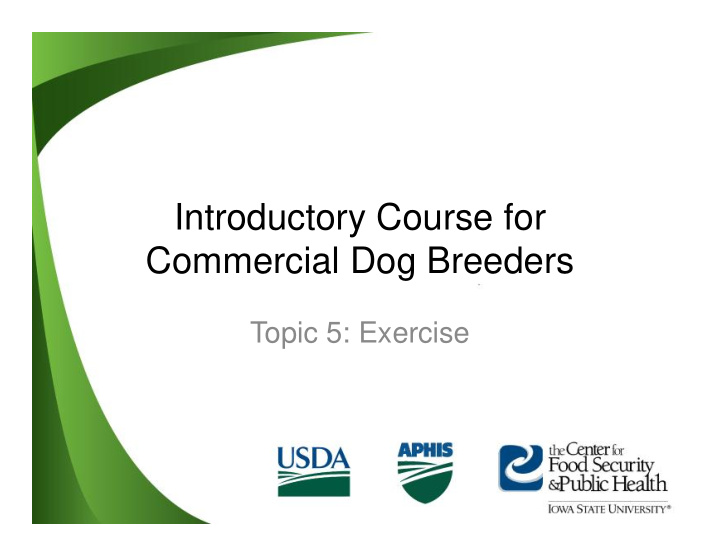



Introductory Course for Commercial Dog Breeders Topic 5: Exercise
Learning Objectives 1. Describe the components of a written exercise plan. 2. Describe exercise requirements for dogs. 3. Describe a few ways in which you can provide exercise for dogs at your facility.
Written Exercise Plan
Written Plan of Exercise AWA requires dealers, exhibitors and research facilities to: –Develop –Document (in writing) –Follow a plan for providing dogs with the opportunity to exercise.
Exercise Plan Requirements • Reviewed and approved by veterinarian • Include standard exercise procedures • Available for APHIS inspection
Exercise Plan Components • Methods • Duration • Frequency • Type of housing: – Individual – Group
Exercise: Exemptions Animal’s health, well-being or condition prohibits exercise Exemptions: – Documented in writing – Reviewed every 30 days • Unless permanent condition – Kept available at all times for APHIS inspectors to review
Exercise Requirements: Individual vs. Group Housing
Exercise: Individually Housed Dogs Dogs housed individually in cages/runs must be provided with regular opportunities to exercise if: – Cages/runs provide less than two times the required floor space for that particular dog
Individually Housed Dogs No additional [(Length + 6”) x (Length +6”)] x 2 = exercise required Minimum floor space (inches) * Exercise required for individual dogs housed in enclosures less than 2x the minimum floor space
Individual Housing: Example “Sparkles” -Scottish Terrier 18 inches from tip of nose to base of tail [(18+6) x (18+6)]= 576 sq. in. minimum floor space 576 x 2= 1152 sq. in. minimum floor space if offering no additional exercise * Convert to square feet: 1152 sq. in. = 8 square feet 144 in per sq. ft
Example cont’d 4 sq. ft. 4 sq. ft. 4 sq. ft. (8 sq. ft. total) Additional exercise No additional exercise opportunities opportunities required required
Group Housing • Dogs over 12 weeks of age • No additional exercise opportunities needed if: – Cage/ run is 100% of the required space for each individual animal
Group Housing Example 12 sq. ft. 4 sq. ft. 4 sq. ft. 4 sq. ft. 4 sq. ft. Additional exercise No additional exercise opportunities required opportunities required
Group Housing: Example
Group Housing: Compatibility Advantages: – Increased exercise – Socialization – Play time Animals over 12 weeks of age may be housed in compatible groups unless: – Health or well-being is affected – Aggressive or vicious behaviors are exhibited
Methods for Providing Exercise Opportunities in Your Kennel
Benefits Exercise, play and positive physical human contact benefits dogs: – Alleviates stress of kenneling – Better socialization Consider exercise and play time even if not required.
Exercise Methods Acceptable methods: – Positive physical human contact and play – Access to an open area/run – Compatible group housing Unacceptable methods: – Treadmill – Swimming – Carousel type walkers
Group Exercise Playroom
Enrichment
Group Housing Exercise
Exercise within Housing Unit
Conclusion You should now be able to: 1. Describe the components of a written exercise plan. 2. Describe exercise requirements for dogs. 3. Describe a few ways in which you can provide exercise for dogs at your facility.
Questions?
Acknowledgments This presentation was prepared by the Center for Food Security and Public Health, Iowa State University through a cooperative agreement with USDA APHIS Animal Care.
Recommend
More recommend